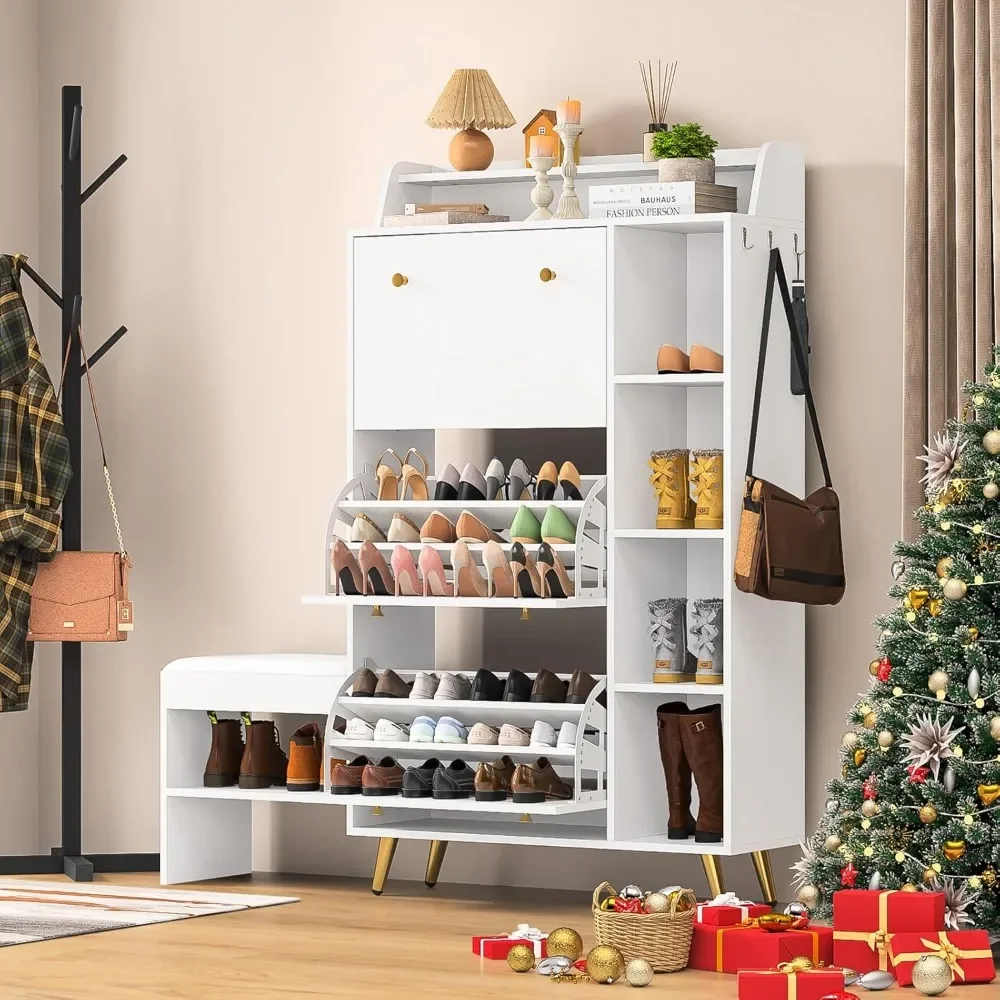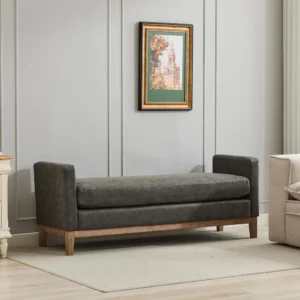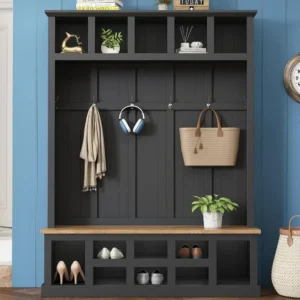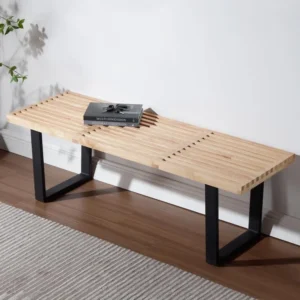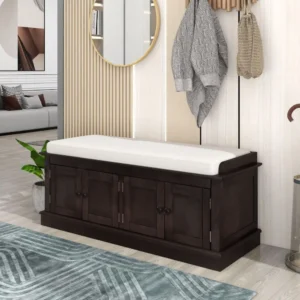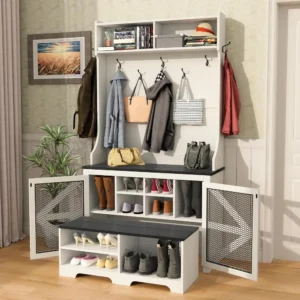Why Durable Seating is Essential for Your Mudroom
Mudrooms serve as the first line of defense against outside elements entering your home. These transition spaces endure constant traffic, seasonal weather changes, and daily wear and tear like no other area in your house. From muddy boots and dripping umbrellas to sports equipment and pet accessories, mudrooms take a beating that requires specially designed furniture.
The seating in your mudroom needs specific qualities to withstand these challenges:
- Moisture resistance: Unlike living room furniture, mudroom seating regularly encounters wet coats, damp shoes, and even melting snow
- Wear resistance: The constant sitting, standing, and leaning actions require reinforced construction
- Weight capacity: Must support multiple users, sometimes simultaneously, as well as bags and backpacks
- Dirt and stain resilience: Easy cleaning is essential for maintaining appearance
Investing in quality, durable seating for your mudroom pays dividends over time. The average household uses mudroom seating 8-12 times daily, with significantly higher use during bad weather or busy seasons. While standard furniture might need replacement within 2-3 years in such conditions, properly designed mudroom seating can last 10+ years with minimal maintenance.
Beyond longevity, durable seating maintains its aesthetic appeal despite harsh conditions. This means your entryway continues to make a positive first impression rather than appearing worn and neglected.
Understanding the full range of functional mudroom seating solutions helps homeowners make smarter investments. The specific requirements of what is a mudroom in a house directly influence the type of seating that will work best in your space.
Bench Options: The Classic Mudroom Solution
When it comes to mudroom seating, benches reign supreme as the most practical and versatile option. Their linear design maximizes seating capacity while minimizing the footprint, making them ideal for narrow entryways and transition spaces.
Benches offer numerous advantages for mudrooms:
- They provide a stable, comfortable place to sit while removing shoes or boots
- Many designs incorporate storage to maximize functionality
- Their simple forms blend with virtually any design style
- They accommodate multiple users simultaneously
Most quality mudroom benches come in standard heights between 17-20 inches (43-51 cm) and lengths ranging from 36-72 inches (91-183 cm). When selecting the right size, allow approximately 24 inches (61 cm) of width per seated person for comfort.
Freestanding Benches: Versatility with Style
Freestanding benches offer the ultimate flexibility in mudroom design, allowing you to reposition your seating as needs change. These movable pieces come in countless styles, from rustic farmhouse to sleek contemporary designs.
Pros:
– Can be moved for cleaning underneath and behind
– Available in numerous ready-made options
– Typically more affordable than built-in solutions
– Can be taken with you if you move homes
Cons:
– May not perfectly fit available space
– Usually offers less storage than custom built-ins
– Might require additional anchoring in high-traffic settings
For maximum durability, look for wood mudroom bench options crafted from solid hardwoods like oak, maple, or acacia. These dense woods resist denting and can withstand years of use. Alternatively, powder-coated metal frames with quality wood seats offer excellent durability with a more contemporary look.
When evaluating freestanding benches, check weight capacity ratings—quality options typically support between 250-400 pounds (113-181 kg), which accommodates multiple users or heavy items.
Built-In Benches: Maximizing Space and Durability
Built-in benches offer a custom-fitted solution that maximizes every available inch in your mudroom. These permanent installations become architectural elements that enhance both the function and value of your home.
Pros:
– Custom-sized to fit your specific space perfectly
– Can be designed around obstacles like heating vents or outlets
– Creates a cohesive, intentional look
– Often utilizes otherwise unusable nooks or corners
Cons:
– Higher upfront investment than freestanding options
– Permanence limits future layout changes
– Requires professional installation for best results
Built-in benches typically cost 30-50% more than comparable freestanding options, but they deliver approximately 25% more usable space through custom sizing and integration with surrounding features. Materials for built-ins should be selected for extreme durability—solid hardwoods, quality plywood with hardwood veneer, or moisture-resistant composite materials perform best in these applications.
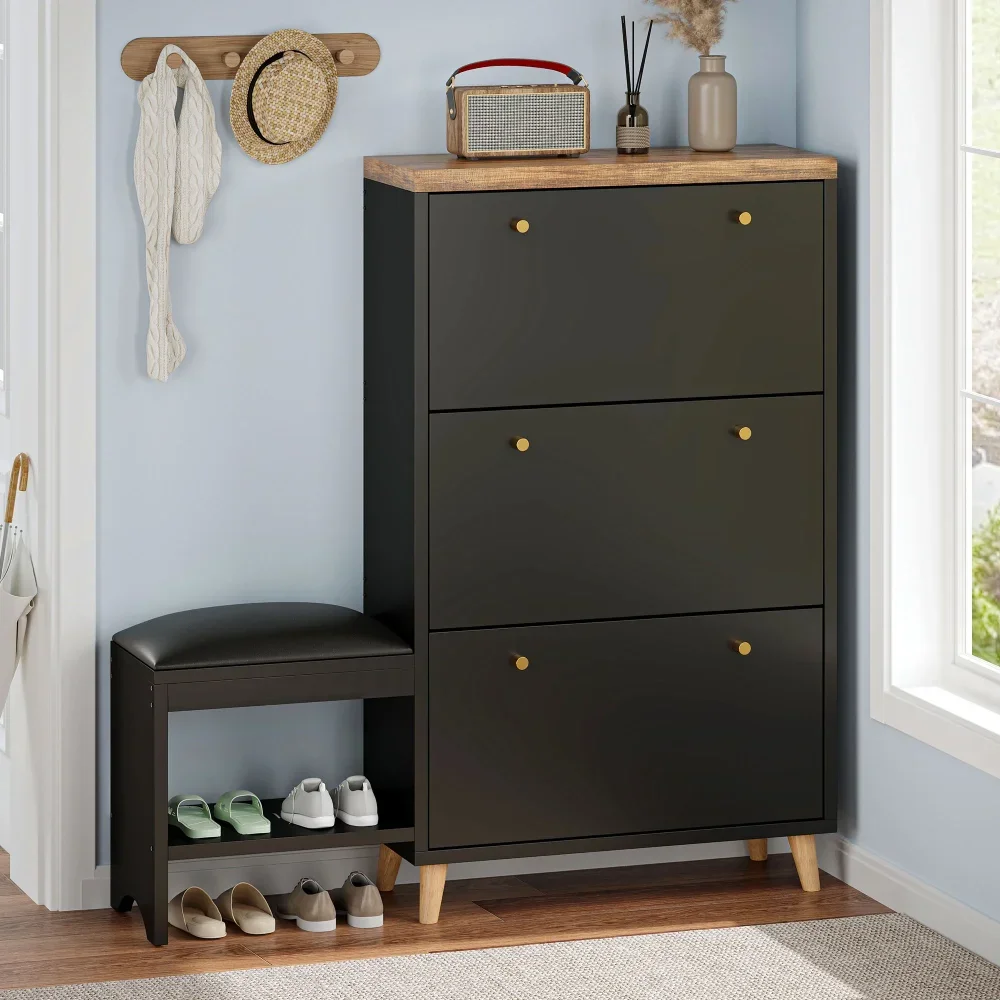
Storage Benches: Practical Functionality
Storage benches represent the perfect marriage of seating and organization, offering hidden compartments for seasonal items, shoes, sports equipment, and other mudroom essentials.
Common storage bench configurations include:
- Lift-top designs: The entire seat lifts to reveal a large storage compartment
- Pull-out drawers: Allow access without removing items from the seat surface
- Open cubbies: Provide visible, accessible storage beneath the seating surface
- Combination designs: Feature multiple storage types for maximum organization
When selecting mudroom bench shoe storage options, pay special attention to the hardware quality. Look for:
- Heavy-duty hinges rated for frequent use
- Soft-close mechanisms to prevent slamming
- Full-extension drawer slides that support at least 75 pounds (34 kg)
- Reinforced corners and stress points
Storage benches typically accommodate 6-12 pairs of adult shoes depending on the design, making them ideal for average households. For families with children, look for divided compartments that help maintain organization among multiple users.
Alternative Seating Options for Mudrooms
While benches remain the most popular mudroom seating solution, they aren’t the only option. Depending on your space constraints and household needs, these alternatives might better suit your situation.
When comparing footprints, individual stools typically require 16×16 inches (41×41 cm) per person, while a standard bench needs roughly 48×16 inches (122×41 cm) for two people. This space efficiency makes alternative seating particularly valuable in smaller homes or apartments with limited entry space.
Many mudroom seating busy homes benefit from mixed seating arrangements that accommodate different user heights and preferences. The right combination depends on your specific household demographics and traffic patterns.
Individual Stools & Chairs: Compact Solutions
Individual stools and chairs offer flexible, space-efficient seating that can be easily repositioned or stored when not in use. These pieces work particularly well in narrow mudrooms or entry spaces where a full bench might overwhelm the area.
Benefits of individual seating:
– Can be tucked under counters or tables when not needed
– Easily moved for cleaning or reconfiguration
– Allows customization for different family members
– Creates visual lightness in small spaces
The ideal height for mudroom stools ranges from 17-19 inches (43-48 cm), providing a comfortable position for removing shoes. For maximum versatility, consider nesting or stacking options that can be condensed when not in use, then expanded for guests or busy mornings.
Durable materials for individual seating include:
– Powder-coated metal frames
– Solid wood with reinforced joints
– High-density polyethylene (HDPE) for easy cleaning
– Commercial-grade molded plastic for extreme durability
Cubbies with Integrated Seating: All-in-One Solutions
Cubby systems with integrated seating provide comprehensive organization for every family member while incorporating comfortable places to sit. These all-in-one solutions define and divide the mudroom space while maximizing functionality.
Mudroom bench cubbies typically feature individual compartments for each household member, with hooks above for coats and bags, and seating that allows access to shoe storage below. A standard four-person cubby system requires approximately 72 inches (183 cm) of wall space and 18 inches (46 cm) of depth, though custom configurations can be adapted to various dimensions.
For durability, look for cubby systems with these characteristics:
– Solid divider walls between compartments for structural strength
– Reinforced seating surfaces that resist flexing
– Quality hardware for hooks and accessories
– Moisture-resistant materials throughout
These systems excel at maintaining organization in busy households, as they visually and physically separate each person’s belongings, reducing clutter and morning confusion.
Material Selection for Maximum Durability
Choosing the right materials for your mudroom seating directly impacts its longevity, appearance, and maintenance requirements. The unique challenges of mudroom environments—moisture, dirt, temperature fluctuations, and heavy use—demand specially selected materials that can withstand these conditions.
Different materials offer varying benefits for best multi-functional seating mudrooms, with trade-offs between durability, maintenance, appearance, and cost. The perfect choice depends on your specific priorities and household conditions.
Woods: Natural Beauty with Proper Protection
Wood remains a perennial favorite for mudroom seating, offering warmth, character, and substantial durability when properly selected and finished. Different wood types provide varying levels of natural resistance to the challenges of mudroom environments.
Comparison of Common Woods for Mudroom Furniture:
| Wood Type | Moisture Resistance | Dent Resistance | Relative Cost |
|---|---|---|---|
| Oak | Medium | High | Medium |
| Maple | Low-Medium | Very High | Medium-High |
| Teak | Very High | High | High |
| Pine | Low | Low | Low |
| Acacia | High | Medium | Medium |
Hardwoods generally outperform softwoods in mudroom applications due to their density and resistance to denting. Regardless of species, proper sealing is essential—look for marine-grade polyurethane or catalyzed lacquer finishes that create water-resistant barriers without requiring frequent reapplication.
Engineered wood products can also perform well when properly sealed at all edges and joints. Quality plywood with hardwood veneer offers excellent dimensional stability, while avoiding the expansion and contraction issues that can affect solid wood in fluctuating humidity levels.
Metals and Synthetics: Modern Durability
Metal and synthetic materials offer exceptional durability for mudroom environments, often exceeding the performance of natural materials in high-moisture conditions. These options provide modern aesthetics while standing up to the toughest use.
Metal options include:
– Steel: Provides maximum strength with weight capacities exceeding 500 pounds (227 kg), but requires proper coating to prevent rust
– Aluminum: Naturally corrosion-resistant and lightweight, ideal for wall-mounted or folding designs
– Wrought iron: Offers classic aesthetics with excellent durability, though it can feel cold in winter months
For extreme durability in challenging environments, consider these synthetic materials:
– High-density polyethylene (HDPE): Impervious to water, easy to clean, and resistant to UV damage
– Polypropylene: Lightweight but strong, with excellent chemical resistance
– Composite materials: Combine wood fibers with plastic for natural appearance with enhanced durability
These modern materials perform particularly well in mudrooms that experience extreme temperature shifts or humidity levels, as they resist warping, cracking, and mold growth that can affect organic materials.
Upholstery and Fabric Options for Comfort
While upholstery might seem counterintuitive for mudroom seating, modern performance fabrics make it possible to incorporate comfortable, attractive textile elements without sacrificing practicality.
For mudroom applications, focus on these fabric characteristics:
– Water and stain repellency (minimum 8,000 mm water resistance rating)
– High abrasion resistance (15,000+ Martindale rubs)
– Mold and mildew resistance
– UV stability if exposed to direct sunlight
Performance fabrics from brands specializing in indoor/outdoor applications offer the best durability for mudroom conditions. Look for options with easy-clean features like removable, machine-washable covers or wipe-clean surfaces.
For maximum practicality, consider upholstery only on seat surfaces, leaving structural elements in more water-resistant materials. This approach balances comfort with the practical realities of mudroom environments.

Essential Features for Mudroom Seating Durability
Beyond material selection, specific construction features and design elements significantly impact how well mudroom seating withstands daily use. These critical details often distinguish truly durable pieces from those that merely look substantial but fail prematurely.
When evaluating seating options for your mudroom, look for these indicators of quality construction:
- Reinforced joints: Mortise and tenon, dovetail, or metal bracket reinforcement
- Quality hardware: Stainless steel or brass components that resist corrosion
- Corner blocks: Additional supports at stress points
- Sealed surfaces: Complete finishing on all surfaces, including undersides
- Elevated design: Feet or base that keeps wood components off potentially wet floors
Mastering mudroom best bench styles requires attention to these construction details alongside aesthetic considerations. Pieces that combine beautiful design with thoughtful engineering will deliver the best long-term value.
Storage Integration: Maximizing Functionality
Effective storage integration transforms basic mudroom seating into comprehensive organization solutions. When evaluating storage features, consider both current and future household needs—the best designs grow with your family.
Effective storage configurations include:
– Shoe shelves: Open shelving accommodates approximately 2-3 pairs of adult shoes per linear foot
– Baskets: Removable containers keep small items organized while allowing air circulation
– Hooks and pegs: Provide vertical storage for bags, coats, and accessories
– Hidden compartments: Conceal seasonal or infrequently used items
For families with children, consider storage solutions that grow with kids—adjustable hooks can be raised as children get taller, while interchangeable components adapt to changing storage needs over time.
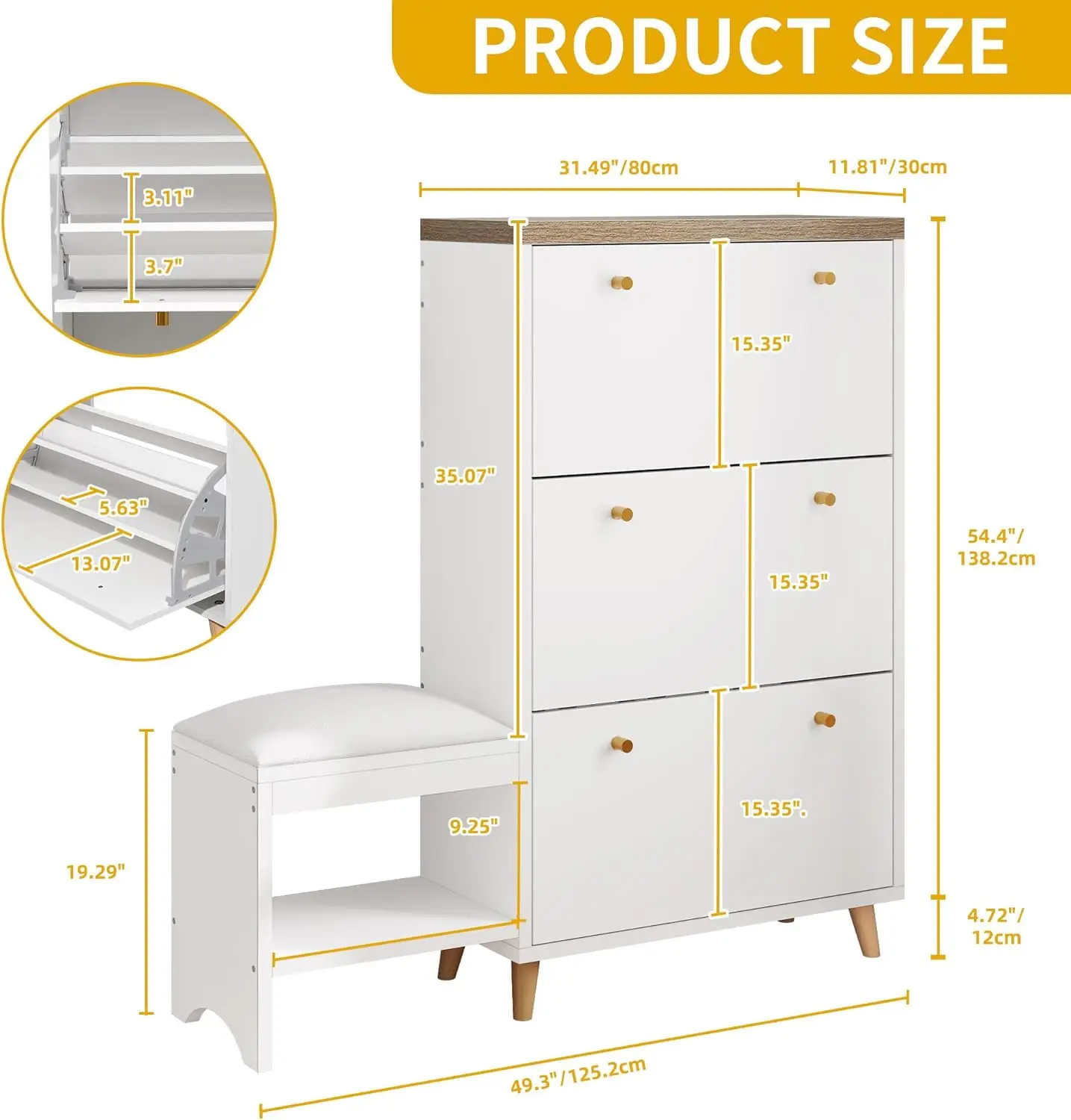
Entryway Bench with Cushion, Mudroom Bench with Cushion, Shoe Bench for Entryway
$1,186.63 Select options This product has multiple variants. The options may be chosen on the product pageBench with Hooks and Storage, Entryway Hall Tree, Mudroom Bench with Cubbies, Mudroom Bench with Shoe Storage
$818.38 Select options This product has multiple variants. The options may be chosen on the product pageModern Entryway Bench, Wood Entryway Bench, Wood Mudroom Bench
$497.69 Select options This product has multiple variants. The options may be chosen on the product pageEntryway Coat Rack Bench, Entryway Hall Tree, Farmhouse Mudroom Bench, Mudroom Bench with Shoe Storage
$805.09 Select options This product has multiple variants. The options may be chosen on the product pageEntryway Bench with Cushion, Mudroom Bench with Cabinets, Shoe Bench for Entryway, Shoe Bench with Cushion
$991.71 Select options This product has multiple variants. The options may be chosen on the product pageBench with Hooks and Storage, Entryway Coat Rack Bench, Entryway Hall Tree, Mudroom Bench with Shoe Storage, Mudroom Coat Rack Bench
$793.73 Select options This product has multiple variants. The options may be chosen on the product page
Construction Quality: What Makes Seating Last
Construction quality often determines the difference between mudroom seating that lasts years versus decades. While not always visible at first glance, these technical details have enormous impact on durability.
Key construction elements to evaluate:
– Joinery techniques: Traditional woodworking joints like mortise and tenon connections offer superior strength compared to simple butt joints with screws
– Hardware specifications: Look for heavy-gauge steel hardware (minimum 12-gauge for structural components)
– Support structures: Cross-braces and corner blocks distribute weight and prevent racking
– Edge treatments: Rounded or reinforced edges resist chipping and damage
For maximum durability, weight capacity should align with household needs. For average families, seating should support at least 250 pounds (113 kg) per person, with higher capacities for households with larger individuals or where multiple people might sit simultaneously.
Design Approaches: Stylish and Durable Mudroom Seating
Durability and style aren’t mutually exclusive—today’s mudroom seating options blend practical functionality with designs that complement your home’s aesthetic. The best mudroom seating feels like an intentional extension of your interior design rather than purely utilitarian furniture.
Consider these design approaches based on your home’s overall style:
– Farmhouse: Natural woods with visible grain, simple lines, and practical features
– Modern: Clean silhouettes, mixed materials, and minimal ornamentation
– Traditional: Classic forms, detailed woodwork, and timeless proportions
– Industrial: Metal components, utilitarian design, and robust construction
Color selections also impact both style and practicality. Medium tones tend to hide dirt and wear better than very light or very dark finishes. For painted pieces, satin or semi-gloss finishes offer better cleanability than matte options.
When selecting dimensions, consider both the physical space and visual weight. In smaller mudrooms, choose seating with exposed legs rather than solid bases to create a sense of openness. For larger spaces, substantial pieces with storage create appropriate visual anchors that define the area.
For comprehensive solutions that address both style and function, multi-functional mudroom benches ultimate guide provides detailed approaches to balancing these sometimes competing priorities.
Maintaining Your Mudroom Seating for Longevity
Even the most durable mudroom seating requires proper maintenance to reach its full potential lifespan. A simple routine maintenance schedule can dramatically extend the life of your investment while keeping it looking its best.
Establish these maintenance habits for maximum longevity:
- Weekly: Wipe down all surfaces with a barely damp cloth to remove dust and light soil
- Monthly: Deep clean with appropriate cleaners for your specific materials
- Seasonally: Inspect all hardware and tighten as needed
- Annually: Apply fresh protective finishes as appropriate for your materials
For wooden seating, prevent moisture damage by immediately addressing spills and wetness. Use coasters or trays under wet boots, and consider adding washable seat cushions that protect wood surfaces while adding comfort.
Metal components benefit from periodic inspection for early signs of corrosion, especially at joints and connection points. Touching up scratched protective finishes prevents rust from taking hold and spreading.
Understanding designing functional mudroom complete guide principles helps homeowners develop effective maintenance routines that preserve both function and appearance.
Where to Find Quality Mudroom Seating
Finding truly durable mudroom seating requires knowing where to look and what specifications indicate quality construction. While price often correlates with durability, informed shopping can identify excellent values at various price points.
Consider these source categories:
Specialty furniture retailers: Focus on stores specializing in solid wood or contract-grade furniture, as these typically offer better construction than mass-market alternatives
Custom woodworkers: Local craftspeople often provide superior materials and construction techniques, though at premium prices
Contract furniture suppliers: Companies that serve commercial environments understand durability requirements and offer appropriate solutions
Quality online retailers: Established companies like Nested Goods that specialize in durable home furnishings often provide detailed specifications and construction information
When evaluating online options, look for detailed descriptions of materials, construction methods, and hardware. Quality retailers provide specific information rather than vague marketing terms. Weight capacity ratings, joinery descriptions, and material specifications indicate attention to durability concerns.
Is DIY Mudroom Seating Right for You?
Building your own mudroom seating can deliver custom solutions perfectly tailored to your space and needs. However, DIY approaches require realistic assessment of skills, tools, and time commitment to ensure satisfactory results.
Pros of DIY mudroom seating:
– Complete customization for your specific space
– Potential cost savings (typically 30-50% for comparable quality)
– Ability to select exact materials and finishes
– Pride of craftsmanship and personal connection
Cons of DIY approaches:
– Requires specialized tools and skills for quality results
– Time investment often exceeds expectations
– Material costs can approach retail prices for small quantities
– Mistakes may compromise durability or appearance
For successful DIY projects, focus on simple designs with straight lines and basic joinery unless you have advanced woodworking skills. Pocket-hole joinery systems offer accessible methods for creating strong connections without specialized equipment.
When selecting materials for DIY projects, invest in the highest quality options your budget allows, particularly for hardware components like hinges and slides that directly impact longevity.
Making the Right Seating Choice for Your Mudroom
Selecting the ideal mudroom seating requires balancing multiple factors specific to your household and space. This decision framework helps prioritize the features most important for your situation:
- Assess daily traffic patterns: How many people use the space simultaneously? At what times of day?
- Evaluate storage needs: What items need regular access versus seasonal storage?
- Measure available space: What dimensions must the seating fit within?
- Consider climate factors: Does your location experience extreme weather conditions?
- Define aesthetic preferences: What style complements your home’s design?
For most households, the most cost-effective approach focuses on quality construction in a timeless style rather than trendy designs. A well-built bench or seating solution typically costs 20-30% more initially but lasts 3-5 times longer than budget alternatives.
Should You Prioritize Storage or Seating in Your Mudroom?
For mudrooms with limited square footage, choosing between maximizing seating or storage often becomes necessary. This decision should reflect your household’s specific patterns and priorities.
Consider prioritizing seating when:
– Multiple family members enter/exit simultaneously
– The space serves as a transition area for changing shoes, outerwear, etc.
– Elderly family members or those with mobility issues need stable seating
– The mudroom frequently accommodates guests
Prioritize storage when:
– The household includes children with sports equipment, backpacks, etc.
– Seasonal items need accessible organization
– Clutter management is a primary concern
– Alternative seating exists nearby
The minimum comfortable seating width per person is approximately 20 inches (51 cm), while basic shoe storage requires about 12 inches (30 cm) of width per family member. These requirements help determine appropriate allocation of limited space.
Does Mudroom Seating Need to Match Your Home’s Interior Style?
While perfect style matching isn’t essential, mudroom seating should complement your home’s overall aesthetic to create a cohesive impression. This transition space bridges the gap between outdoors and interior, making it an ideal area for style blending rather than sharp contrasts.
Effective approaches include:
– Choosing similar wood tones or finishes to other nearby spaces
– Incorporating accent colors from adjacent rooms
– Matching hardware finishes (brushed nickel, bronze, etc.) with other visible elements
– Using complementary rather than identical styles
Simple ways to coordinate without exact matching include adding cushions or accessories that reference colors from adjacent spaces, or selecting hardware that matches other visible elements like door handles or light fixtures.
For entryways that transition into formal spaces, shoe-friendly seating options foyers can provide guidance on maintaining style cohesion while addressing practical concerns.
The most successful mudroom designs balance practical durability with aesthetic connections to the rest of your home, creating spaces that feel purposeful and integrated rather than merely functional.

